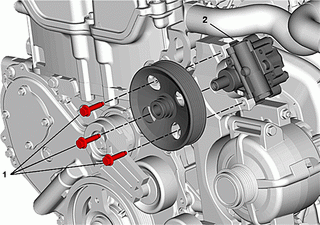Chevrolet Captiva Service & Repair Manual: Power Steering Pump R&R
| Access power steering pump bolts
through holes in power steering pump pulley. Pulley is illustrated off pump
for clarity only, it is not required to remove pulley in vehicle. |
| 1. |
Remove power steering fluid reservoir. |
| 2. |
Remove power steering gear inlet hose
at power steering pump. |
| 3. |
Remove power steering pump bolts,
Fig. 1. |
| 4. |
Remove power steering pump, Fig.
1. |
| 5. |
Transfer components, as required. |
| 6. |
Reverse procedure to install, noting
following: |
| |
a. |
Torque power steering pump bolts
to 16 ft. lbs. |
| |
b. |
Fill and bleed power steering system. |
|

Fig.
1
Removing the power steering pump from a Chevrolet Captiva involves several steps to ensure a safe and successful procedure. So park the vehicle on a flat surface and engage the parking brake. It's also advisable to disconnect the negative battery terminal to prevent any accidental electrical issues during the process. This step ensures a safe working environment.
Next, drain the power steering fluid from the reservoir using a suitable container. This prevents spills and leaks during the pump removal. It's essential to handle the fluid carefully to avoid any environmental contamination.
After draining the fluid, you'll need to remove the power steering pump belt. This typically involves loosening the tension on the belt using the appropriate tools. Depending on the model year and configuration of your 2016 Captiva, you may need to adjust the tensioner or loosen specific bolts to release the belt.
With the belt removed, disconnect the hoses attached to the power steering pump. Be prepared for residual fluid to drain from the hoses during this step. It's a good idea to have rags or absorbent materials handy to clean up any spills promptly.
Once the hoses are disconnected, remove the bolts securing the power steering pump to the engine block or mounting bracket. Keep track of the bolts and their locations for ease of reassembly later on. Carefully lift the power steering pump from its mounting position, taking care not to damage any surrounding components.
After removing the pump, inspect it for any signs of damage or wear. If necessary, replace the pump with a new or refurbished unit. When installing the new pump, follow the reverse of the removal process: reconnect hoses, secure mounting bolts, and reattach the drive belt with proper tension.
Then refill the power steering fluid reservoir with the recommended type of fluid and bleed any air from the system according to the manufacturer's instructions. Once everything is reassembled, start the engine and test the power steering system for proper operation. Address any leaks, unusual noises, or steering issues promptly.
Steering Gear Outlet & Fluid Reservoir Inlet
Removal
1.
Remove as much power steering fluid
from power steering fluid reservoir as possible.
...
Use clean, new power steering
fluid type only.
Hoses touching frame, body or
engine may cause system noise. Verify that hoses do not touch any other
section of vehicle. ...

 Power Steering Line R&R
Power Steering Line R&R Power Steering System Bleed
Power Steering System Bleed